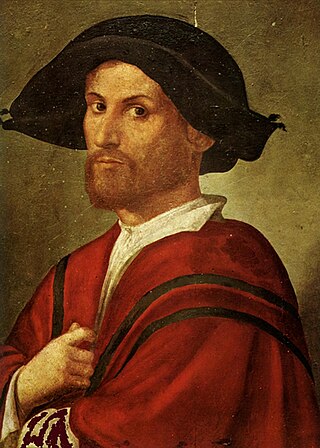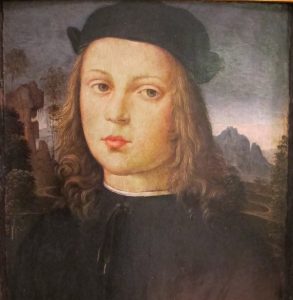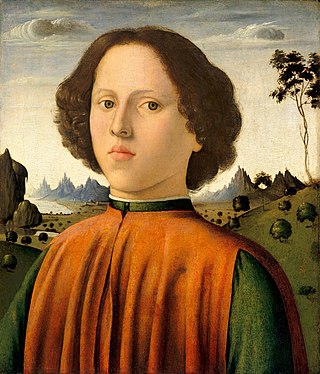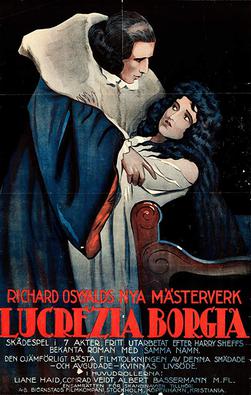
Lucrezia Borgia was an Italian noblewoman of the House of Borgia who was the daughter of Pope Alexander VI and Vannozza dei Cattanei. She reigned as the Governor of Spoleto, a position usually held by cardinals, in her own right.

Pope Alexander VI was head of the Catholic Church and ruler of the Papal States from 11 August 1492 until his death in 1503. Born into the prominent Borgia family in Xàtiva under the Crown of Aragon, Rodrigo studied law at the University of Bologna. He was ordained deacon and made a cardinal in 1456 after the election of his uncle as Pope Callixtus III, and a year later he became vice-chancellor of the Catholic Church. He proceeded to serve in the Curia under the next four popes, acquiring significant influence and wealth in the process. In 1492, Rodrigo was elected pope, taking the name Alexander VI.

The House of Este is a European dynasty of North Italian origin whose members ruled parts of Italy and Germany for many centuries.

The House of Borgia was an Italian-Aragonese Spanish noble family, which rose to prominence during the Italian Renaissance. They were from Valencia, the surname being a toponymic from the town of Borja, then in the Crown of Aragon, in Spain.

Giovanni Borgia, 2nd Duke of Gandía (1476–1497) was the second born and the second son of Pope Alexander VI and Vannozza Cattanei and a member of the House of Borgia. He was the brother of Cesare, Gioffre, and Lucrezia Borgia. He was murdered on 14 June 1497. Even today, it is not known with certainty who was responsible for his death, although many at the time blamed his brother Cesare.

Prince of Foxes is a 1947 historical novel by Samuel Shellabarger, following the adventures of the fictional Andrea Orsini, a captain in the service of Cesare Borgia during his conquest of the Romagna.

Ercole II d'Este was Duke of Ferrara, Modena and Reggio from 1534 to 1559. He was the eldest son of Alfonso I d'Este and Lucrezia Borgia.
Giovanni Sforza d'Aragona was an Italian condottiero, lord of Pesaro and Gradara from 1483 until his death. He is best known as the first husband of Lucrezia Borgia. Their marriage was annulled on claims of his impotence in March 1497.
Giovanni Borgia, known as the Infans Romanus, was born into the House of Borgia in secret and is of unclear parentage. Speculations of the child's parentage involve either Lucrezia Borgia with her alleged lover, Perotto Calderon or Cesare Borgia, or Pope Alexander VI as his father. Cesare Borgia's biographer Rafael Sabatini says that the truth is fairly clear: Alexander fathered the child with an unknown Roman woman.

Alfonso of Aragon, Duke of Bisceglie and Prince of Salerno of the House of Trastámara, was the illegitimate son of Alfonso II King of Naples and his mistress Trogia Gazzella. His father, cousin of King Ferdinand II of Aragon, abdicated in favour of his legitimate son Ferdinand II of Naples.

Sancha of Aragon, or Sancia of Aragon, was an illegitimate daughter of King Alfonso II of Naples and his mistress Trogia Gazzella. In 1494, she was married to Gioffre Borgia, youngest son of Pope Alexander VI. Upon her marriage, she and her husband were created Prince and Princess of Squillace, a province in the south of Italy. For the majority of their marriage, Sancha and her husband lived in the Vatican with the rest of his family. There Sancha became friends with her sister-in-law Lucrezia, and allegedly had affairs with both of her husband's older brothers: Juan Borgia, 2nd Duke of Gandia, also known as Giovanni Borgia, and Cesare Borgia. Her affair with Juan is sometimes said to be the reason for Cesare's alleged murder of Juan in 1497.

Prince of Foxes is a 1949 American historical adventure film adapted from Samuel Shellabarger's novel Prince of Foxes. The movie starred Tyrone Power as Orsini and Orson Welles as Cesare Borgia. It was nominated for two Oscars during the 22nd Academy Awards: Best Black and White Cinematography and Best Costume Design, Black and White.

Gioffre Borgia (1481/82–1516/17), also known as Goffredo (Italian), or Jofré Borja (Valencian), was the youngest son of Pope Alexander VI and Vannozza dei Cattanei, and a member of the House of Borgia. He was the youngest brother of Cesare, Giovanni, and Lucrezia Borgia.
Orsino Orsini Migliorati (1473–1500) was the husband of Giulia "La Bella" Farnese (1474–1524), the mistress of Pope Alexander VI.

The Borgias is a historical fiction drama television series created by Neil Jordan; it debuted in 2011 and was canceled in 2013.

Rodrigo of Aragon, Duke of Bisceglie and Sermoneta of the House of Trastámara, was the only child of Lucrezia Borgia, daughter of Pope Alexander VI, and her second husband Alfonso of Aragon, son of Alfonso II of Naples.

Lucrezia Borgia is a 1922 German silent historical film directed by Richard Oswald and starring Conrad Veidt, Liane Haid, Paul Wegener, and Albert Bassermann. It was based on a novel by Harry Sheff, and portrayed the life of the Renaissance Italian aristocrat Lucrezia Borgia (1480–1519). Botho Hoefer and Robert Neppach worked as the film's art directors, designing the period sets needed. It was shot at the Tempelhof Studios in Berlin. Karl Freund was one of the cinematographers. Famed French director Abel Gance remade the film in 1935.

Lucrezia d'Este was an Italian noblewoman. By birth she was a member of the House of Este, and by marriage to Francesco Maria II della Rovere, Duke of Urbino she was Duchess consort of Urbino and Sora, and Lady consort of Pesaro, Senigallia, Fossombrone and Gubbio.

Ferrante d'Este was a Ferrarese nobleman and condottiero. He was the son of Ercole I d'Este and Eleonora d'Aragona - he was named after his mother's father Ferdinand I of Naples. His five siblings were Alfonso I d'Este, cardinal Ippolito d'Este, Isabella d'Este, wife of Francesco II Gonzaga, Beatrice d'Este, and Sigismondo d'Este. His two illegitimate half-siblings were Giulio and Lucrezia d'Este.

Young Lucrezia is a 1974 Italian historical drama film directed by Luciano Ercoli and starring Simonetta Stefanelli, Massimo Foschi and Ettore Manni.

















